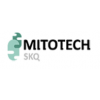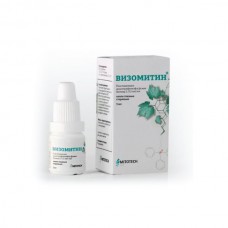Expiration date: 01/2027
Active substance: Plastohinonildeciltriphenylphosphonium bromide
Pharmacodynamics
Plastohinonilde?iltriphenylphosphonium bromide (PDTF) plastoquinone is derived which, via a linker chain (C10) is associated with residual triphenylphosphine. PDTF at low (nanomolar) concentrations shows a high antioxidant activity. Also has a stimulating effect on the process of tear production, epithelialization, it contributes to the stability of the tear film. According to a clinical study in patients with age-related cataract drug protects the eye tissues from oxidative damage by increasing the antioxidant activity of tears, improves visual acuity.
Pharmacokinetics
Pharmacokinetic studies in humans have not been conducted. In preclinical animal studies PDTF distribution in organs and tissues occurred within 48 hours after the in / and intragastric administration. It was found that PDTF present in the highest concentrations in renal tissue, liver, heart and for 1 hour after administration. PDTF relatively quickly subjected to enzymatic cleavage, and covalent bonding to proteins.
Testimony:
- dry eye syndrome
- the initial stage of age-related cataract (to slow the progression of the disease in order to delay surgery).
Contraindications
- hypersensitivity to the drug;
- age 18 years.
Pregnancy and breast-feeding
Adequate controlled trials have not been conducted in pregnant and breast-feeding women. Not recommended to prescribe the drug during pregnancy. If necessary, the appointment during lactation in the period of treatment should stop breastfeeding.
Side effects
- Allergic reactions.
- From the senses: possible transient burning sensation and cramps in her eyes after instillation.
Interaction
If necessary, it can be used simultaneously with the other eye drops. The break between the instillation must be at least 5 minutes.
Dosing and Administration
Locally (in the conjunctival sac). 1-2 drops of the drug 3 times a day. Duration of treatment is determined by the doctor depending on the severity of symptoms.
Use of the drug in the treatment of age-related cataract should be under the supervision of a physician, who must conduct regular monitoring of the patient in order to assess the need for surgical intervention, depending on the progression of the disease. In a clinical study of the use of the drug lasted 6 months.
Overdose
Overdosage information local application no.
Special instructions
Effects on ability to drive vehicles and mechanisms. If after treatment there is a short-term blurred vision, until his recovery is not recommended to drive and engage in activities that require high concentration.
Release Form
Eye drops, 0.155 g / ml. In 5 ml PE bottle with a cork-dropper and screw cap; 1 fl. In the paper cartons.
Storage preparation
In the dark place at a temperature of 2-8 ° C.
Keep out of the reach of children.
Shelf-life
2 years. Opened vial used within 1 month.
Do not use beyond the expiration date printed on the package.
The unique properties of the drug Vizomitin®
Mitochondria - specific organelles found in most cells in our body. They are cellular power plants - produce and store energy, which is then consumed by the cell.
Schematic representation of an animal cell.
A byproduct of the production of useful energy are reactive oxygen species (ROS). Excessive amounts of ROS with oxidative stress cause serious harm to the cell. And although most cells have the means of struggle against excess ROS, in the case of some diseases such as ROS produced by mitochondria, are a signal of irreversible cell death (apoptosis). In this situation insufficient natural remedies.
Medicine has long invented ways to combat excessive free radicals - are antioxidants.
The main problem - the absence of drugs directed to the mitochondria. Since it is the mitochondria are a major source of ROS in a cell, to be delivered to these organelles significant amounts of antioxidant. Omnidirectional drug will thus be distributed throughout the cell and the organism that causes the use of massive doses, most of which does not reach the mitochondria.
"Skulachev ions", on which the drug Visomitin® set have unique properties entering the cells, they are sent directly to the mitochondria. Therefore Visomitin® is the world's first registered antioxidant targeting to mitochondria.
Published results of a large-scale clinical studies of the project Academician Skulachev
December in the journal «Advances in Therapy» largest scientific publisher Springer published a paper summarizing the results of an international multicenter clinical trial of the drug Visomitin at patients with a syndrome of "dry eye."
A double-blind, placebo-controlled study was conducted from 2012 to 2014. It was attended by 240 patients followed in eight Russian and two Ukrainian medical centers. Comparison was made with the placebo group receiving the drug instead of moisturizing drops of the same composition that Visomitin preparation, but do not contain the active ingredient - mitochondrial antioxidant SkQ1 ( «Skulachev ion").
The result confirmed the effectiveness and safety Visomitin drug in patients with the syndrome of "dry eyes". Compared with patients receiving placebo in the group Visomitin was found significantly more effective healing of corneal lesions, decrease the severity of symptoms and subjective improvement of the tear film. The study design allowed for the observation of patients within six weeks after the end of treatment. It was found that most of the severity of symptoms Visomitin was lower in the group for another 2 - 4 weeks after therapy. Thus it was first demonstrated reliable postterapevtichesky SkQ1 effect of mitochondrial antioxidant composed Visomitin drug.
The composition of the authors of works included leading ophthalmologists of Russia, as well as a group of researchers from MSU. University led by scientific director of the project Academician VP Skulachev.
Visomitin
(SkQ1
Skulachev
Ion)
- Brand: Mitotech




